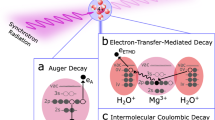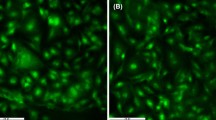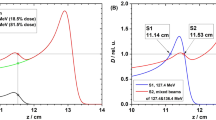Abstract
RADIATION ‘dose’ is usually defined and measured in terms of the ionization produced in air. However, for biological dosage purposes it would be theoretically preferable to measure effects produced in media similar in composition to living tissue, and there are considerable experimental advantages in a direct measurement of the radiation energy dissipation in liquid or solid media1,2. Our experiments, with X-rays, gamma-rays and beta-rays, confirm that radiation absorption in aqueous solutions can be accurately measured by purely chemical means.
This is a preview of subscription content, access via your institution
Access options
Subscribe to this journal
Receive 51 print issues and online access
$199.00 per year
only $3.90 per issue
Buy this article
- Purchase on SpringerLink
- Instant access to full article PDF
Prices may be subject to local taxes which are calculated during checkout
Similar content being viewed by others
References
Fricke and Morse, Phil. Mag., 7, 129 (1929).
Miller, Nature, 162, 448 (1948).
Weiss, Nature, 153, 748 (1944); Trans. Farad. Soc., 43, 314 (1947).
Stein and Weiss, Nature, 161, 650 (1948).
Farmer, Brit. J. Radiol., 18, 148 (1945).
Clayton and Farmer, Brit. J. Radiol., (in the press).
Gray, Read, et al., Brit. J. Radiol., 13, 371 (1940).
Author information
Authors and Affiliations
Rights and permissions
About this article
Cite this article
DAY, M., STEIN, G. Chemical Measurement of Ionizing Radiations. Nature 164, 671–672 (1949). https://doi.org/10.1038/164671a0
Issue date:
DOI: https://doi.org/10.1038/164671a0
This article is cited by
-
Effect of High Dose Rates on Survival of Mammalian Cells
Nature (1967)
-
A Highly Sensitive Chemical Dosimeter for Ionizing Radiation
Nature (1958)
-
A Simplified Chemical Method of Radiation Dosimetry
Nature (1951)
-
L'action indirecte du rayonnement X et ultra-violet
Experientia (1951)
-
Chemical Effects of Ionizing Radiation in some Gels
Nature (1950)



